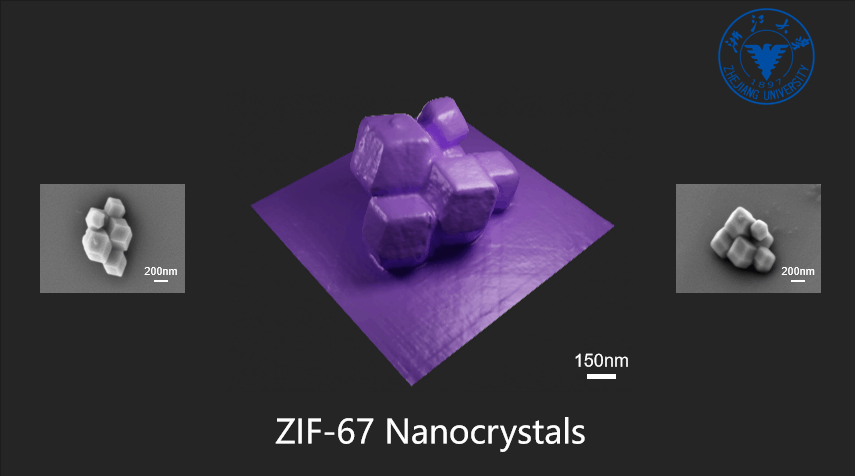In this repository, we provide a framework that achieves 3D surface reconstruction of intricate micro-/nanostructures based on multi-view scanning results from a commercial atomic force microscopy(AFM) and a standard probe. To the best of our knowledge, this is the first time neural implicit surface reconstruction techniques have been applied to nanotechnology. We hope our method becomes a cost-effective tool for researchers to analyze 3D micro-/nanostructures.
In our experiments, MVN-AFM successfully reconstructed 3D surface models of TPL microstructures (2~3.5 μm), PMMA nanospheres (~500 nm), and ZIF-67 nanocrystals (~300 nm).We tested our method on a commercial AFM, Bruker Icon, working in tapping mode. The probe we used was the TESPA-V2 (Bruker), which has a height of 15 μm, an overall shape of a quadrilateral pyramid, a front angle of 25°, a back angle of 17.5°, and a side angle of 20°.
These two animations briefly demonstrate the conventional AFM scanning and the multi-view AFM scanning process.
conventional.mp4
multi-view.mp4
This is the model of our tilt sample stage, consisting of a base with a tilt angle and a circular turntable. You can access our .STEP design models for both parts here and construct this stage by 3D printing. Since our method does not require the tilt angle as a priori information, users can redesign the sizes of the stage based on the AFM you are using.
Following this tutorial, we show how to convert the raw data from multi-view AFM scanning into the data format required for later program processing.
- A graphic card with memory larger than 12 gigabytes.
- PyTorch>=1.10
pip install git+https://github.com/NVlabs/tiny-cuda-nn/#subdirectory=bindings/torchpip install -r requirements.txt- See here for more details of software requirements.
We have organized the commands for the entire framework into the script run.sh, and the 3D surface reconstruction of the sample can be automatically accomplished by simply running the following command.
./run.sh
MVN_AFM_DIR is the folder of MVN-AFM. DATA_NAME is the folder name within load/ where multi-view AFM data for a sample is saved. DATA_NUM is the number of AFM multi-view scans of the sample, which defaults to 9 in our experiments, and the user can modify this value according to your collected data.
This program aligns the multi-view AFM data into the same coordinate. The multi-view AFM images for a sample in .npz format are placed in the input_folder, and the solved coordinate transformation (poses) of each view will be added to the .npz files, keeping other elements unchanged.
python mv_align.py --input_folder load/${DATA_NAME}/ --data_num ${DATA_NUM}
This code cross-validates the AFM data in the input_folder based on current poses and AFM values saved in the .npz files. The threshold is set to make the algorithm robust to noises in the AFM data and inaccurate poses during the iteration. The solved AFM masks will be added to the .npz files.
python compute_mask.py --input_folder load/${DATA_NAME}/ --threshold ${THRESHOLD} --data_num ${DATA_NUM}
This program performs neural implicit surface reconstruction of the micro-/nanostructures based on the multi-view AFM data with poses and masks solved by previous steps. After about 8 minutes of training on an RTX4090 graphics card, we extract a .obj model of the sample surface from the network.
python launch.py --config configs/afm.yaml --gpu ${GPU_NUM} --train dataset.scene=${DATA_NAME} tag=reconstruct trial_name=reconstruction name=${DATA_NAME} dataset.root_dir=./load/${DATA_NAME}/
Thanks instant-nsr-pl for providing nice implementation of instant neural implicit surface reconstruction.
We used a free 3D model from sketchfab in our animation.
If you find this code/work useful in your own research, please consider citing the following:
@misc{chen2024multiview,
title={Multi-View Neural 3D Reconstruction of Micro-/Nanostructures with Atomic Force Microscopy},
author={Shuo Chen and Mao Peng and Yijin Li and Bing-Feng Ju and Hujun Bao and Yuan-Liu Chen and Guofeng Zhang},
year={2024},
eprint={2401.11541},
archivePrefix={arXiv},
primaryClass={cs.CV}
}

